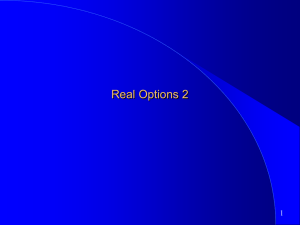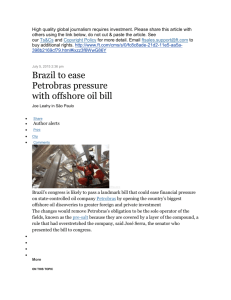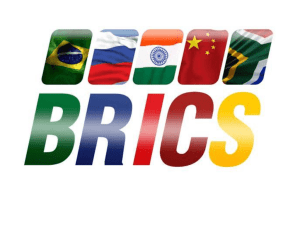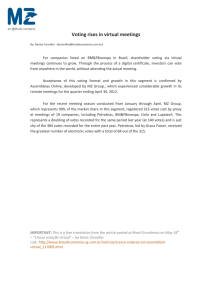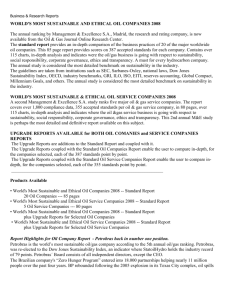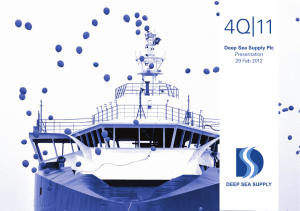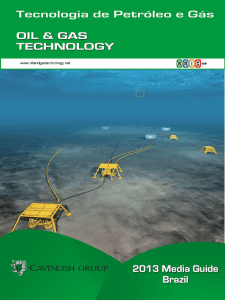The Petrobras Debt Challenge
advertisement
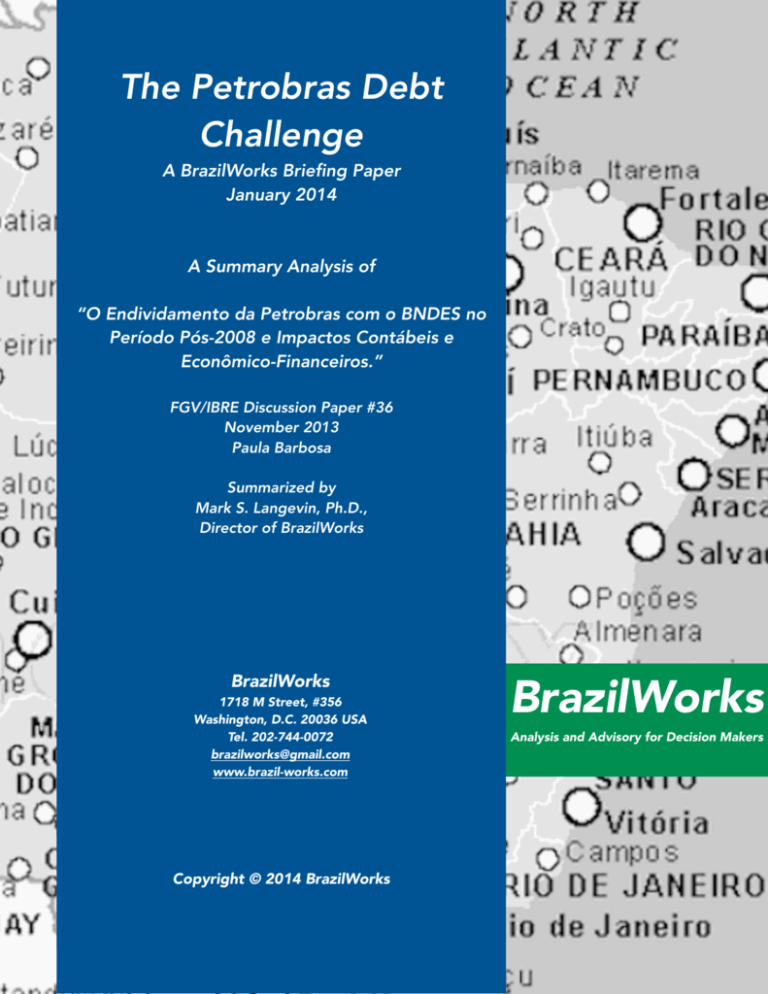
The Petrobras Debt Challenge A BrazilWorks Briefing Paper January 2014 A Summary Analysis of “O Endividamento da Petrobras com o BNDES no Período Pós-2008 e Impactos Contábeis e Econômico-Financeiros.” FGV/IBRE Discussion Paper #36 November 2013 Paula Barbosa Summarized by Mark S. Langevin, Ph.D., Director of BrazilWorks BrazilWorks 1718 M Street, #356 Washington, D.C. 20036 USA Tel. 202-744-0072 brazilworks@gmail.com www.brazil-works.com BrazilWorks Analysis and Advisory for Decision Makers Copyright © 2014 BrazilWorks The Petrobras Debt Challenge / A BrazilWorks Brie9ing Paper / January 2014 1 The Petrobras Debt Challenge A BrazilWorks Briefing Paper January 2014 A Summary Analysis of “O Endividamento da Petrobras com o BNDES no Período Pós-2008 e Impactos Contábeis e Econômico-Financeiros.” FGV/IBRE as Discussion Paper #36 November 2013 Written by Paula Barbosa1 Summarized by Mark S. Langevin, Ph.D., Director of BrazilWorks 2 BrazilWorks provides advisory and consulting services to Brazilian and United States based private sector enterprises, civil society organizations, and policymakers interested in Brazilian market structure, regulatory frameworks, public policies and political risk, and economic development as well as United StatesBrazil relations. BrazilWorks specializes in agriculture, biofuels, capital goods, climate change, defense procurement, energy, healthcare, local content policies, producer association dialogue and cooperation, and international commercial and investment negotiations and policies. BrazilWorks 1718 M Street, #356 Washington, D.C. 20036 USA Tel. 202-744-0072 brazilworks@gmail.com www.brazil-works.com 1 Paula Barbosa is an economist. She earned her undergraduate degree from the Federal University of Rio de Janeiro, a Masters from the Pontifical Catholic University of Rio de Janeiro, and a MBA from INSEAD in France. She has worked in both financial institutions and multinational petroleum and mining firms. 2 Dr. Langevin is Director of BrazilWorks, International Advisor to the Associação Brasileira dos Produtores de Algodão (Abrapa), Associate Adjunct Professor of Government and Politics at the Universty of MarylandUniversity College (UMUC), and Guest Lecturer at UniCEUB in Brasilia. Dr. Langevin researches and writes extensively on Brazilian energy policymaking and United States-Brazil relations. He is a regular contributor to such publications as: American Diplomacy, Boletim Meridiano 47, Brazzil, the Inter-American Dialogue’s Latin American Advisor, Journal of Energy Security, the Labor Studies Journal, Review of Renewable Energy Law and Policy, and Universitas: Relações Internacionais. Dr. Langevin earned a Ph.D. in Political Science and a M.A. in Latin American Studies from the University of Arizona in Tucson. The Petrobras Debt Challenge / A BrazilWorks Brie9ing Paper / January 2014 2 The Petrobras Debt Challenge A BrazilWorks Briefing Paper January 2014 Paula Barbosa provides a timely analysis of Brazil’s government controlled energy company, Petrobras, and its debt and performance since the global financial crisis hit Brazil in 2008. Her purpose is to offer a detailed understanding of the problems and challenges facing Petrobras from the perspective of its accumulating debt as well as its core business operations in oil and gas exploration and production and downstream refining and distributing. The major problematic for Barbosa is government provided financing, mostly through the Banco Nacional de Desenvolvimento, known as the BNDES. This following summary analysis provides an English summary interpretation of Barbosa’s cogent analysis in the aftermath of the recent, first production-sharing auction for offshore, pre-salt blocks in the Libra field in which Petrobras played the central role. The Macroeconomic Context The Brazilian economy enjoyed stable growth from 2004 to 2008 at an annual average of 2.5% with historically low inflation. Stable growth and low inflation was also accompanied by a steady exchange rate and relatively low unemployment for Brazilian standards. Following the collapse of Lehman Brothers in September of 2007, the ensuing financial crisis, and the downturn in global demand for Brazilian commodity exports, the national government launched a series of counter-cyclical measures, including stimulus related fiscal policy and an expansion of business and consumer credit. Along with these compensatory policies the government instituted modifications to its accounting methods; measures that have been widely debated in recent years because of their lack of transparency and tendency to understate public debt based financing of Petrobras investment. Petrobras Since 2008 Without a doubt Petrobras is the most important enterprise in Brazil due in large measure to its investment program and its overall impact upon national economic development. Petrobras is one of the five largest national oil companies (NOCs) in the world and privileged with the promise of increasing booked reserves and distinguished by its renowned competitive advantages in ultra-deep-water drilling. However, the company’s share value has tumbled in the past three years, raising questions about the performance and planning of the most important company in Brazil. At its most recent height, Petrobras ordinary shares rose to $50.56 a share on May 26, 2007, but the stock tumbled to $17.04 by November 17th of that same year and in the immediate aftermath of the collapse of Lehman Brothers in September. The company’s stock value rose throughout much of 2008 and 2009, reaching a high of $38.90 on November 23, 2009 before its subsequent decline-a trend that continued throughout 2013. In September of The Petrobras Debt Challenge / A BrazilWorks Brie9ing Paper / January 2014 3 2010 Petrobras’ special offering sold $69.97 billion in shares at $17.25 per share, the largest offering of its kind on the New York Stock Exchange, largely to finance investments in exploration and production of the “pre-salt reserves. Despite all of the exuberance radiating from Brazil’s oil and gas bonanza, Petrobras’ share price has steadily retreated from its most recent high in November of 2009 to approximately $16 a share by December of 2013. As Graph I reports, during the past 18 months Petrobras share value has lost some 50 percent. Graph 1: Petrobras Stock Price (USD) March 2012 to January 2013 Barbosa discovers a sui generis relationship between the trajectory of Petrobras stock and the AMEX OIL Index which tracks the average value of the largest United States oil and gas companies stock values. Since 2012, the AMEX OIL index has increased approximately 40 percent while that of Petrobras has retreated by approximately 50 percent. This dramatic fall in stock value, in stark contrast to the AMEX OIL Index, parallels Petrobras’ falling profitability and rapid increase in debt. Barbosa claims that the company’s financial and operational performance is challenged by increasing debt, retail prices set by government regulators, the needed increase in refinery investment to meet rising national demand for transportation fuels, and the imposition of local content policies for the sector. Accordingly, the company’s annual net profits have fallen from approximately $20 billion in 2008 to half that by the end of 2012. Petrobras’ Profitability Petrobras’ profitability has declined significantly since its peak in 2010 with over $24 billion USD in reported net profit. Table 1 reports net profit by business activity from 2006 to 2012 and reveals that recent losses in refining, biofuels, corporate administration, and the reported losses from restructuring assets (Adjustments and Eliminations). The sales of natural gas for electricity generation rebounded in 2009 and shows steady profitability, in part due to The Petrobras Debt Challenge / A BrazilWorks Brie9ing Paper / January 2014 4 rising demand for power in Brazil (see BrazilWorks Briefing Paper Brazilian Electricity 101). As Table 1 shows, the largest challenge to Petrobras’ profitability comes from the downstream activities in which federal government policy sets the pump prices for transportation fuels. Petrobras lost over $16 billion USD in refining alone in 2011 and 2012, and the 2012 loss supercedes the company’s consolidated net profit of just over $10 billion. Table 1: Petrobras Net Profit by Business Activity and Year, 2006-2012 (reported in millions USD) Business Activity Exploration and Production Refining 2006 2007 2008 2009 2010 2011 2012 $17,315 $19,989 $22,379 $13,158 $20,283 $22,366 $23,672 $4,272 $4,402 -$2,461 $9,224 $2,540 -$5,495 -$11,024 -$830 -$1,028 -$172 $479 $873 $1,729 $833 0 0 0 0 0 -$86 -$104 Distribution $409 $615 $752 $850 $866 $647 $862 International $246 -$762 -$1,013 -$78 $901 $1,084 $690 -$2,925 -$6,075 $969 -$2,453 -$779 -$801 -$2,591 Natural Gas-Energy Biofuels Corporate Adjustments and -$362 -$1,088 $249 -$680 -$649 -$1,193 -$439 Eliminations Consolidated Net $18,124 $16,028 $20,702 $20,500 $24,040 $18,251 $10,076 Profit Source: The reported figures are based on Barbosa’s Tabela 3-page 9, but are reported in USD based on the average USD-BRL exchange rate each year as reported by OANDA and accessed at: http://www.oanda.com/ currency/average. Transportation Fuel Price Regulation According to Barbosa, Petrobras’ refinery activity profitability has rapidly contracted since 2011, largely as the result of the government’s fuel price policy regime. From 2011 to July of 2013, Petrobras has lost some $20 billion USD in this activity alone. The Centro Brasileiro de Infraestrutura (CBIE) reports that between 2008 and 2010 the gaps between fuel prices paid in Brazil and those related to U.S. production in the Gulf of Mexico were accumulating and stabilized around a full 25 percent differential. Despite government price readjustments, this differential has remained throughout most of 2013. Barbosa reports that Adriano Pires, Director of CBIE, estimates that between 2003 and 2013 Petrobras has lost some $20 billion USD to the price gap between Brazil’s government set fuel prices and world prices. Indeed, gasoline sales increased 58 percent between 2008 and 2012 thereby lessening the company’s profitability. The impact of the price differential is also amplified when national supply is insufficient and Petrobras must import crude oil, gasoline, and diesel to satisfy the rising demand. Barbosa also presents information suggesting that exchange rate flutuations can also lessen profitability under such conditions. Ironically, Petrobras may be the only oil and gas company that loses money selling transportation fuels at the pump. The Petrobras Debt Challenge / A BrazilWorks Brie9ing Paper / January 2014 5 Petrobras Debt and Investment Since the discovery of the massive offshore “pre-salt” reserves and their official government recognition in 2007, Petrobras has administered an ambitious five-year investment plan of over $200 billion. This investment plan requires substantial borrowing from both private and Brazilian public banks, including BNDES, Banco do Brasil, and the Caixa Econômica Federal (CEF). Indeed, as Barbosa reports, Petrobras’ debt has grown by approximately 206% between 2006 to December of 2012. Approximately 60 percent of Petrobras debt is due in 2018. The combination of mounting national demand for transportion fuels coupled with the massive investments required to carry out the exploration and production activities related to the pre-salt reserves led the company to borrow to fully finance the upstream activies along with an ambitious downstream refinery reform and construction agenda (See the BrazilWorks Briefing Paper: Infrastructure Investment in Northeastern Brazil). Most of Petrobras’ debt is held by private banks and denominated in foreign currency, mostly USD. 65 percent is held by these private banks with an average annual interest rate at 4.3 percent while Brazil’s public banks hold some 35 percent, but at an annual interest rate of 7.6 percent in nominal terms, but when adjusted for inflation the cost of this source of public finance falls to 2-3 percent, well below the market rate. The publicly financed debt, largely through the BNDES, increased by 291 percent in 2008 and 129 in 2009 and composing 77.4 and 77.2 percent of all acquired debt for these respective years-in part a government countercyclical response to the downward economic swing. Indeed, by 2012 loans to Petrobras represented over 30 percent of the BNDES portfolio, calling into question this bank’s exposure to Petrobras’ ambitious investment plans. The distribution of Petrobras investment parallels the company’s net profit by business activity. Table 2 reports the relative distribution of Petrobras investments with exploration and production accounting for 51 percent and downstream refining infrastructure at 34.3 percent in 2012. According to Barbosa, this downstream activity has attracted a steady increase in investments over time, composing only 22 percent in 2008 and growing to over a third of all investment by 2012. Much of these increases are devoted to reconfiguring current refineries to better process the national crude oil production, increase the supply of diesel, and increase the overall quality of transportation fuels as mandated by the Agência Nacional do Petróleo, Gás Natural e Biocombustíveis (ANP). In addition, significant investments are devoted to natural gas production, biofuels, and transportation fuel distribution. Table 2 also reports the return on investment margins by business activity for 2012 and reveals that Exploration and Production continue to be the best investment for Petrobras, followed by distribution activities. Return on investment from biofuels continues to lose money, but this outcome is clearly dependent upon government fuel price policies. Corporate activities, including human resources and organizational structuring, are not structured as profit centers. Rather, this activity serves to provide administrative support and organizational The Petrobras Debt Challenge / A BrazilWorks Brie9ing Paper / January 2014 6 planning, but certainly the large losses suggest that more could be done to achieve efficiencies in this activity area. Table 2: Petrobras Investment by Business Activity for 2012 Business Activity Relative Share of Investment, 2012 51% Return on Investment, 2012 1.06 34.3% -0.79 Natural Gas-Energy Biofuels 5% 6% 0.42 -0.73 Distribution International 1.6% 0.4 % 1.37 0.28 Exploration and Production Refining Corporate 1.7% Consolidated Return on Investment -3.75 0.26 Source: Reported by Barbosa, Table 5-page16. The Consequences of Petrobras’ Recent Performance In November of 2011 Moody’s downgraded Petrobras’ credit rating, suggesting that the rapid and notable increase in debt, the low liquidity, and falling profitability justified the change. Along with this downgrade, Moody’s also lowered the credit rating of Brazil’s public banks, including the BNDES and the CEF. The ratings services Fitch and Standard and Poor’s also downgraded Petrobras in 2012 and 2013 respectively. Barbosa quotes Fitch to summarize the state of Petrobras’ financial health, “Petrobras’ credit metrics will deteriorate in the coming 2 to 3 years due to its aggressive investment plan and the consequent budgetary gap.” Barbosa reminds the readers that Petrobras was upgraded to investment grade investment in 2005, before the federal government was upgraded thereafter. Hence, Barbosa explores this problematic by providing a detailed analysis of the relationships between Petrobras, public investments made to this state controlled company through government banks, especially the BNDES, and the aggregate impact on public finance in Brazil-a timely cautionary tale for policymakers and Petrobras corporate leadership. Indeed, in June of 2013 Standard and Poor’s revised the federal government credit rating perspective from stable to negative, citing the sluggish economy and expansionary fiscal policy (this includes the growing exposure of the BNDES and the CEF to Petrobras) as the prime factors behind its pessimistic forecast. Given Petrobras recent and disappointing performance, Barbosa provides four basic scenarios to understand the direction of the The Petrobras Debt Challenge / A BrazilWorks Brie9ing Paper / January 2014 7 company and its debt management. In all of these scenarios, government control and policymaking play critical roles in deciding the fate of Petrobras. Barbosa explains that in most cases shareholders would work to discipline the company’s operational and debt management to raise profitability, but that in the case of Petrobras the only shareholder that matters is the government. This may explain why Petrobras private shareholders are much less active in corporate management and governance when compared with those of other major, publicly traded multinational oil and gas firms. Barbosa recommends that the crux of Petrobras’ increasing debt, the so-called “crossed indebtedness” of both the company and the government banks, be confronted. Her recommendation suggests that such loan practices be minimized and that the National Treasury sell Petrobras debt securities to lessen the government banks’ exposure to the company and make the government’s own control more transparent and responsive in comparison to the current loaning practices which obscure the structure of the company’s debt as it relates to public finance. Moreover, Barbosa recommends: 1. Eliminating excessive government regulation of fuel prices; 2. Terminating the production sharing regime mandate that Petrobras control at least 30 percent of all pre-salt exploration and production; 3. Relaxing of local content policies to allow Petrobras to exploit promising procurement efficiencies; 4. Restructuring to lower the costs of financial and operational management. Overall, Barbosa presents a comprehensive and detailed analysis of Petrobras’ primary challenges as they relate to debt management and profitability. This 63-page report is an excellent resource for understanding the recent performance of Brazil’s iconic enterprise; and how its recent dive into debt jeopardizes its performance as well as Brazilian public finance in the coming years. Accordingly, the tipping point may come in 2018 when much of the company’s debt comes due precisely when oil and gas production levels are forecasted to outpace national demand and thereby creating a significant supply for export. Moreover, policymakers must reform the transportation fuel policy to cut the national-world price differential in order to raise Petrobras profitability so that it can meet its debt obligations and continue to invest in production for export. The Petrobras Debt Challenge / A BrazilWorks Brie9ing Paper / January 2014 8
